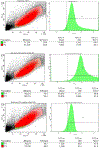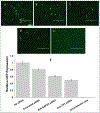Selenium-Dependent Read Through of the Conserved 3'-Terminal UGA Stop Codon of HIV-1 nef
- PMID: 35128545
- PMCID: PMC8813066
- DOI: 10.25259/ajbps_6_2021
Selenium-Dependent Read Through of the Conserved 3'-Terminal UGA Stop Codon of HIV-1 nef
Abstract
The HIV-1 nef gene terminates in a 3'-UGA stop codon, which is highly conserved in the main group of HIV-1 subtypes, along with a downstream potential coding region that could extend the nef protein by 33 amino acids, if readthrough of the stop codon occurs. Antisense tethering interactions (ATIs) between a viral mRNA and a host selenoprotein mRNA are a potential viral strategy for the capture of a host selenocysteine insertion sequence (SECIS) element (Taylor et al, 2016) [1]. This mRNA hijacking mechanism could enable the expression of virally encoded selenoprotein modules, via translation of in-frame UGA stop codons as selenocysteine (SeC). Here we show that readthrough of the 3'-terminal UGA codon of nef occurs during translation of HIV-1 nef expression constructs in transfected cells. This was accomplished via fluorescence microscopy image analysis and flow cytometry of HEK 293 cells, transfected with engineered GFP reporter gene plasmid constructs, in which GFP can only be expressed by translational recoding of the UGA codon. SiRNA knockdown of thioredoxin reductase 1 (TR1) mRNA resulted in a 67% decrease in GFP expression, presumably due to reduced availability of the components involved in selenocysteine incorporation for the stop codon readthrough, thus supporting the proposed ATI. Addition of 20 nM sodium selenite to the media significantly enhanced stop codon readthrough in the pNefATI1 plasmid construct, by >100%, supporting the hypothesis that selenium is involved in the UGA readthrough mechanism.
Conflict of interest statement
Conflicts of Interest All authors declare that they have no conflicts of interest.
Figures








Similar articles
-
Cellular Selenoprotein mRNA Tethering via Antisense Interactions with Ebola and HIV-1 mRNAs May Impact Host Selenium Biochemistry.Curr Top Med Chem. 2016;16(13):1530-5. doi: 10.2174/1568026615666150915121633. Curr Top Med Chem. 2016. PMID: 26369818 Free PMC article. Review.
-
Identification of the Selenoprotein S Positive UGA Recoding (SPUR) element and its position-dependent activity.RNA Biol. 2019 Dec;16(12):1682-1696. doi: 10.1080/15476286.2019.1653681. Epub 2019 Aug 21. RNA Biol. 2019. PMID: 31432740 Free PMC article.
-
Factors impacting the aminoglycoside-induced UGA stop codon readthrough in selenoprotein translation.J Trace Elem Med Biol. 2016 Sep;37:104-110. doi: 10.1016/j.jtemb.2016.04.010. Epub 2016 Apr 26. J Trace Elem Med Biol. 2016. PMID: 27157664
-
A recoding element that stimulates decoding of UGA codons by Sec tRNA[Ser]Sec.RNA. 2007 Jun;13(6):912-20. doi: 10.1261/rna.473907. Epub 2007 Apr 24. RNA. 2007. PMID: 17456565 Free PMC article.
-
Mechanism and regulation of selenoprotein synthesis.Annu Rev Nutr. 2003;23:17-40. doi: 10.1146/annurev.nutr.23.011702.073318. Epub 2003 Jan 8. Annu Rev Nutr. 2003. PMID: 12524431 Review.
Cited by
-
Selenium, Stroke, and Infection: A Threefold Relationship; Where Do We Stand and Where Do We Go?Nutrients. 2023 Mar 15;15(6):1405. doi: 10.3390/nu15061405. Nutrients. 2023. PMID: 36986135 Free PMC article. Review.
-
SARS-CoV-2 Main Protease Targets Host Selenoproteins and Glutathione Biosynthesis for Knockdown via Proteolysis, Potentially Disrupting the Thioredoxin and Glutaredoxin Redox Cycles.Antioxidants (Basel). 2023 Feb 23;12(3):559. doi: 10.3390/antiox12030559. Antioxidants (Basel). 2023. PMID: 36978807 Free PMC article.
-
Modular Polymerase Synthesis and Internal Protein Domain Swapping via Dual Opposed Frameshifts in the Ebola Virus L Gene.Pathogens. 2024 Sep 25;13(10):829. doi: 10.3390/pathogens13100829. Pathogens. 2024. PMID: 39452701 Free PMC article.
References
-
- Zhong L; Arner ES; Holmgren A Structure and mechanism of mammalian thioredoxin reductase: the active site is a redox-active selenolthiol/selenenylsulfide formed from the conserved cysteine-selenocysteine sequence. Proc Natl Acad Sci U S A 2000, 97, 5854–5859, doi:10.1073/pnas.100114897. - DOI - PMC - PubMed
-
- Taylor EW; Cox AG; Zhao L; Ruzicka JA; Bhat AA; Zhang W; Nadimpalli RG; Dean RG Nutrition, HIV, and drug abuse: the molecular basis of a unique role for selenium. J Acquir Immune Defic Syndr 2000, 25 Suppl 1, S53–61. - PubMed
Grants and funding
LinkOut - more resources
Full Text Sources
Miscellaneous
